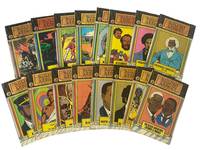signed
by Black Troops, Postwar
Photo Album of an African American Serviceman in Postwar Germany, 18th Infantry Regiment, 1st Infantry Division, mid 1950s. Oblong folio photo album containing 102 vernacular silver gelatin photographs, primarily 3.5 x 5 in., some with deckled edges, mounted recto and verso on black paper. Several images stamped on verso: "Foto-Proplesch, Aschaffenburg." Uniforms and insignia in photographs identify the compiler as a Black American soldier of the 18th Infantry Regiment, 1st Infantry Division, stationed in West Germany during the early years of military integration.
An exceptional visual record of an African American soldier serving in occupied West Germany in the late 1950s, documenting both military life and interracial camaraderie during the U.S. Army's first decade of full integration. The album's compiler is seen repeatedly, appearing with fellow Black and white GIs in moments of leisure, training, and social life. The patch on his left shoulder in multiple images clearly identifies him as a member of the 1st Infantry Division (the "Big Red One"). Several photos were taken outside a building marked by a placard reading: "H Co. / 18th INF," confirming his assignment to Company H of the 18th Infantry Regiment, a component of the U.S. Army Europe command headquartered in Aschaffenburg at the time.
Military equipment visible in the album includes M1 steel helmets, M1 Garand rifles, and at least one M1919 Browning .30 caliber medium machine gun used in training exercises. Jeeps and supply trucks marked with white star U.S. Army symbols are shown in snowy conditions. One photo shows the compiler using a field radio, while another captures a weapons demonstration or training drill involving mounted infantrymen and commanding officers. Many images depict informal downtime: soldiers smiling in barracks, posing by tents, dining at cafes with local German women, and in one notable image, a group of African American GIs sit with a white woman in a bar, sharing cigarettes and beer with visible ease.
Crucially, the album captures the lived experience of racial integration in the U.S. military during a pivotal period. Executive Order 9981, signed by President Truman in 1948, ordered the desegregation of the armed forces, but implementation took years. By the mid-1950s, most Army units in Europe were among the first to be fully integrated. Aschaffenburg, located in the U.S. occupation zone of West Germany, became home to several Black regiments during this period. While African American soldiers faced segregation at home, in Europe they often encountered greater freedom and less racial animosity, as reflected in the ease and camaraderie visible throughout the album. Some additional snapshots appear to depict life back in the United States, including a series of children and women posed in domestic settings, likely family members. The album spans both personal and professional spheres, from deployment and patrol to street scenes and portraits with children. Very good condition overall. (Inventory #: 22284)
An exceptional visual record of an African American soldier serving in occupied West Germany in the late 1950s, documenting both military life and interracial camaraderie during the U.S. Army's first decade of full integration. The album's compiler is seen repeatedly, appearing with fellow Black and white GIs in moments of leisure, training, and social life. The patch on his left shoulder in multiple images clearly identifies him as a member of the 1st Infantry Division (the "Big Red One"). Several photos were taken outside a building marked by a placard reading: "H Co. / 18th INF," confirming his assignment to Company H of the 18th Infantry Regiment, a component of the U.S. Army Europe command headquartered in Aschaffenburg at the time.
Military equipment visible in the album includes M1 steel helmets, M1 Garand rifles, and at least one M1919 Browning .30 caliber medium machine gun used in training exercises. Jeeps and supply trucks marked with white star U.S. Army symbols are shown in snowy conditions. One photo shows the compiler using a field radio, while another captures a weapons demonstration or training drill involving mounted infantrymen and commanding officers. Many images depict informal downtime: soldiers smiling in barracks, posing by tents, dining at cafes with local German women, and in one notable image, a group of African American GIs sit with a white woman in a bar, sharing cigarettes and beer with visible ease.
Crucially, the album captures the lived experience of racial integration in the U.S. military during a pivotal period. Executive Order 9981, signed by President Truman in 1948, ordered the desegregation of the armed forces, but implementation took years. By the mid-1950s, most Army units in Europe were among the first to be fully integrated. Aschaffenburg, located in the U.S. occupation zone of West Germany, became home to several Black regiments during this period. While African American soldiers faced segregation at home, in Europe they often encountered greater freedom and less racial animosity, as reflected in the ease and camaraderie visible throughout the album. Some additional snapshots appear to depict life back in the United States, including a series of children and women posed in domestic settings, likely family members. The album spans both personal and professional spheres, from deployment and patrol to street scenes and portraits with children. Very good condition overall. (Inventory #: 22284)




























